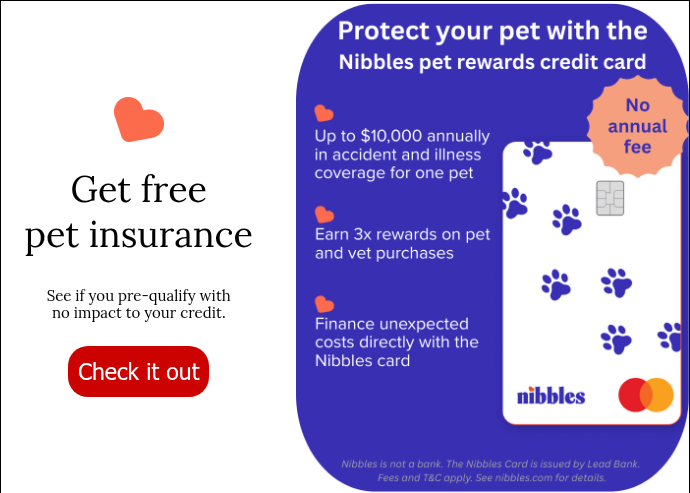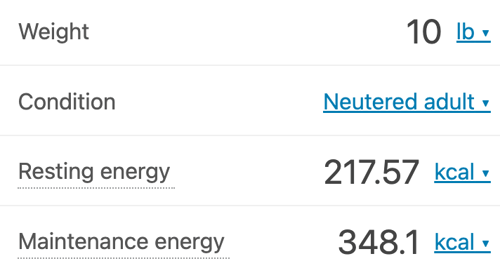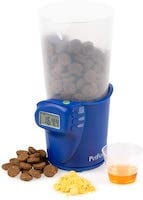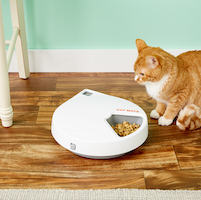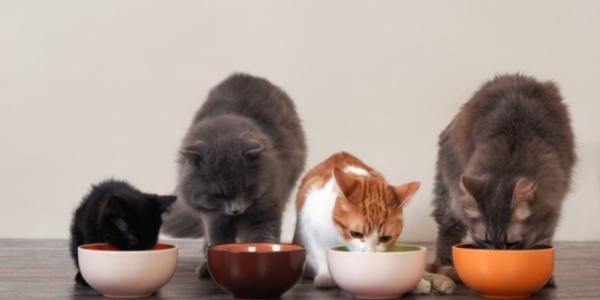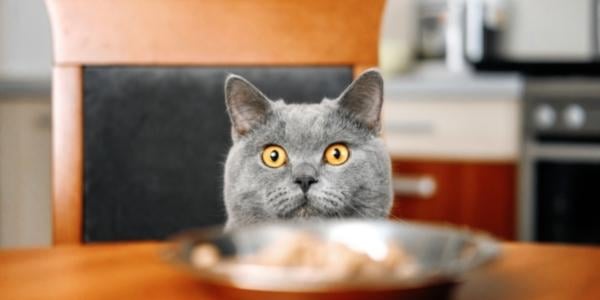 Many cat owners, myself included, love a big chunky cat.
Many cat owners, myself included, love a big chunky cat.
Maybe it’s because they seem cuddlier — when they are in the mood to cuddle, that is.
Or perhaps we feel more loved when they are begging for food or purring as we feed them.
But in reality, as cute as they may be, excess weight isn’t healthy for our cats. Studies show that pets on the leaner side live longer than their heavier counterparts.
Also, cats with a healthy body weight will suffer less from issues like arthritis and other illnesses.
The best way to show love is by managing your cat’s weight to help them live a long and healthy life.
How Much Should You Feed Your Cat?
Should You Feed the Amount Listed on the Cat Food Package?
Measuring Your Cat's Food
How Often Should You Feed Your Cat?
General Cat Feeding Guidelines
Cat Diet Tips
Let’s get started on some basics of how you can help your furry friend lose weight and keep it off.
One of the first things I suggest is consulting with your cat’s veterinarian. They can guide you on how much weight your cat needs to lose, how much to feed them, and how to establish an exercise routine for your cat.
It is recommended — just like it is for people — to have your cat get a complete physical exam and possibly blood tests to be sure there are no underlying medical issues before starting a weight loss program.
How Much Should You Feed Your Cat?
How much you should feed your cat is dependent on several factors. In reality, there is no one-size-fits-all for feeding. Each cat is an individual with their own unique needs. Therefore, feeding amounts could vary as much as 50% above or below average. This is one reason consulting with your veterinarian about meal portion size is recommended.
Factors That Affect How Much to Feed Your Cat
Age
Kittens require a lot of nutrients and have a high energy requirement. As a beginning guideline, the estimated average daily caloric requirement for a growing kitten is about 300 to 500 calories per day. Kittens should gain about 1 pound per month if they are normal and healthy.
Adult cats and senior cats have less caloric intake requirements, averaging about 20 calories per pound of body weight (45 calories/kg of body weight) a day.
An example of calories per day based on average weights for the categories:
- Kittens 0 to 4 months with a weight range of 1 to 5 lbs: 77.38 to 353.2 kcal
- Kittens 4 months to adult with a weight range of 5.5 to 10 lbs: 258.73 to 453.1 kcal
- Spayed/Neutered adult about 10 lbs: 348.1 kcal
- Intact adult about 10 lbs: 391.6 kcal
To calculate your cat’s daily caloric requirement based on their exact weight and condition, try this calculator.
In the calculator example below, you would feed a 10-lb neutered male between 217.57 and 348.10 kcals a day, depending on their age and activity level and, of course, all of the other factors listed below (i.e., medical conditions, etc.).
1 kcal = 1 calorie. Kcal is simply a measurement used in veterinary medicine.
Resting energy represents the energy your cat’s body needs to perform basic bodily functions (e.g., digestion).
Maintenance energy represents your cat’s daily caloric requirements, i.e., typically the maximum you should feed your cat.
NOTE: You should feed your cat based on their life stage since each life stage has its own caloric and other nutritional needs. For example, kitten food is higher in calories per serving than adult food.
If your adult cat is eating kitten food, they are consuming more, likely significantly more, calories than they need. A cat is considered an adult at one year old.
Size
Cats vary in size. Maine Coons, which are considered to be a larger breed of cat, will need to eat more than a smaller breed cat, such as a Siamese.
Also, cats can vary in their body frame size. Smaller-framed or “petite” cats require less food than larger-framed or “big-boned” cats.
Activity level
Cats who tend to lay around burn way fewer calories than a cat who gets a lot of exercise. Also, every cat has their own unique metabolic rate (the rate at which they burn calories). Some are high, and others are low.
Indoor versus Outdoor
Outdoor cats tend to burn more calories than indoor cats, as they are usually more physically active.
Body condition
Overweight cats need fewer calories since they are often less active. Learn more about helping your cat lose weight.
Health status
Certain diseases alter the type and amount of protein that should be in a cat’s food. Some illnesses such as hyperthyroidism, affect a cat’s metabolic rates causing them to burn more calories. Cats with kidney disease need high-quality, low-protein diets.
Reproductive Status
Pregnant and nursing cats have a higher caloric requirement due to the nutritional demands on their body during those times. But spayed and neutered cats need a reduction in the number of calories due to a slower metabolism from the lack of hormones.
Your veterinarian will help you determine the right caloric requirements for your cat's health, age, and overall needs.
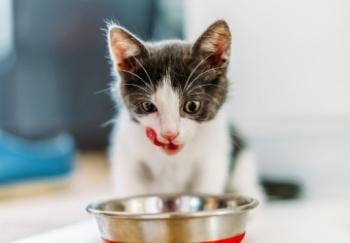 Should You Feed the Amount Listed on the Cat Food Can or Bag?
Should You Feed the Amount Listed on the Cat Food Can or Bag?
The directions on your cat’s food bag are just rough (in some cases, VERY rough) guidelines. Their purpose is to cover ALL life situations, and amounts are often set for the most demanding of those, such as an unneutered male cat.
Each cat has their own unique needs. The guidelines on food bags can be significantly more or less than what your cat needs.
You can use it as a starting point, but be sure to adjust the amounts, either up or down, to what is appropriate for your cat to meet the goal of weight loss or maintenance.
As a general average, if you are feeding a commercially produced high-quality dry food with a good quality protein source, then an indoor cat would be fed about 1/3 to 1/2 cup of food per day. This amount of quality food is approximately between 167–250 calories.
For cat owners that prefer canned wet food, the average calories for a 5.5 oz can is 150–200 (but check the label — there are a lot of differences between brands).
As shown on the wet food label (photo below), from a 3-oz food pouch, a serving is 72 kcal. So, an average 10-lb neutered male cat would need approx 3–4 servings a day.
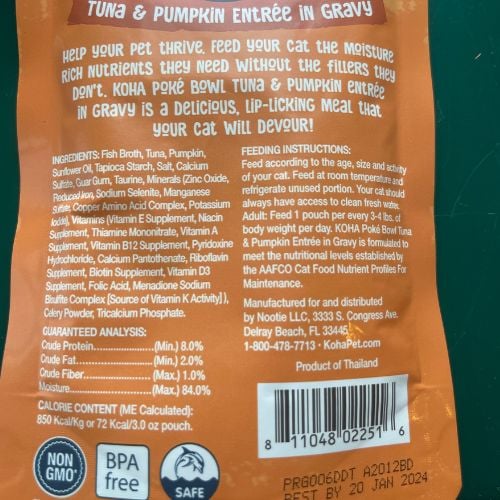
Compared to dry food, canned wet food has a higher moisture content as well as fewer calories than the same volume of dry food. Determining the amount per day (number of cans) will require a little bit more work than scooping a cup of dry food.
So, when transitioning from dry to wet, you will need to take the time to check and be sure your cat is getting enough or not too much canned wet food per day.
On average, a 10-lb neutered adult male cat should consume about 20 calories per pound of body weight, which is about 200 calories per day. This is assuming the cat is of average weight for their size and has a sedentary to mildly active lifestyle.
Some cats, those that are young and quite active, in this weight range, can consume up to 300 to 350 calories without gaining weight. Start with feeding about 200 calories and increase or decrease depending on if your cat loses or gains weight.
To monitor, weigh your cats weekly at home and keep a log. Increase the calories by 20 to 25% if they are losing weight. If they are gaining weight, cut back about 5% every couple of weeks after determining their ideal daily caloric intake to maintain their ideal weight.
NOTE for losing weight: To help cats lose weight as well as for other medical reasons, your veterinarian may recommend you switch your cat to canned food or feed it with their dry food.
While many cats will take to canned wet food very easily, others will not. My cats REFUSED to eat canned food!
To encourage your cat to eat wet food, try the following:
- Try a variety of different wet cat food flavors and brands.
- Warm up the wet food in the microwave. Of course, make sure that the food is not too hot before giving it to your cat by touching it with your finger.
- Add a little bit of warmed, low-sodium chicken broth to the wet food. Avoid broths containing onions, onion powder, chives, or garlic (which can be toxic to cats).
- Add some meat baby food as a topper. Again, make sure the baby food contains no onions or garlic.
- Sprinkle some nutritional yeast powder on their food.
The above suggestions, as well as others, are available in our article, Your Cat Won’t Eat? Tips and Reasons Why.
When you are trying to determine whether to decrease or increase the amount of food, using the guidelines on the food label, weigh your cat weekly to monitor for any changes in weight.
If you start to notice that their weight is slowly creeping up, every ounce counts, then you likely need to decrease the amount you are feeding or increase their activity level.
Stay in the habit of weighing your cat routinely. This will help keep you both on track!!
Questions? If you would like to speak with a veterinarian about your cat's eating habits, Click here
Measure Your Cat's Food
It is very important to measure your cat's food with a proper measuring cup. Why should this matter to you as a cat owner? It matters because when it comes to your cat’s weight and their overall health, the myriad of empty containers people frequently use to scoop their cat's kibble aren't the “cups” we veterinarians (and the back of the pet food bags) are talking about.
This especially becomes a problem when a cat owner feeds the number of cups the pet food bag suggests, and they are using an extra-large coffee cup variety.
Using a Digital Scale to Measure Cat Food
As doctors always say, “The scale doesn’t lie!” That is why measuring your cat’s food by weight rather than volume is more accurate. While a measuring cup is great, we can always be off a little when we eyeball how much is in the measuring cup.
And the size of dry kibble can affect how much food actually fits in a measuring cup. But when you know the weight of what you should feed your cat, you can be exact every time you feed with a digital scale.
A kitchen scale can work, or consider using a handheld digital pet food scale like the portable and handheld one from Petfusion, featured below, which makes it easier to measure weight quickly or while on the go.
Your cat's food should have the calories per kg listed on the packaging, which can help you determine the correct weight to feed based on your cat's daily caloric needs.
Why Measuring Your Cat's Food Matters
Why is measuring your pet’s food so important? It's important because the pet obesity rate in the U.S. (and in many other countries, too) has truly ballooned to epidemic proportions.
Obesity in pets contributes to other health issues, such as osteoarthritis or diabetes in cats. And while overfeeding a pet their regular food isn’t the only contributing factor, it certainly is a big one — and it’s one that’s often the easiest to change.
There are HUGE advantages to measuring your cat’s food. For one thing, your cat will be much healthier. Animals at ideal body weight are easier for your veterinarian to examine, and it also allows more accurate bloodwork results.
Additionally, many flea and tick preventative doses are based on weight. You not only have to administer less medication (that is especially nice with cats!), but you also save money.
While some medications are based on your pet’s exact weight because of how they are distributed throughout the body, others are based on your pet’s ideal body weight. If your pet is overweight or obese, your pet’s veterinarian has to make assumptions as to what their ideal weight is.
Therefore, they may play it safe, using a slightly higher weight than the true ideal of your pet. This can make a big difference in the cost of medications.
Typically, heartworm prevention and flea/tick prevention are more affordable for lower weights. Just a couple of pounds can be the difference between which dose your cat gets if they are on the borderline of two different sizes.
Lastly, you will save a bunch of money on pet food because you are not overfeeding your cat and not going through a bag or cans of food as fast.
How Often Should You Feed Your Cat?
This is a highly debated topic, and the answer is unique to your cat.
Some cats are like cows and like to graze on food all day (and night). Others like eating at set times of the day and don’t let you forget what that time is.
The big factor, whether you leave food out all the time, feed several meals, or just two meals a day, is to make sure you aren't giving them more calories than their daily intake needs.
You should not just fill the bowl whenever it’s empty — this can lead to your cat becoming overweight or obese. Not all cats are good at regulating how much to eat at a meal.

Feed Your Cat at Least Twice a Day
Outdoor cats can hunt 20+ times a day and eat 7+ meals depending on what they catch. Each one is about the size of a mouse. In fact, their stomachs are only as big as a ping pong ball.
It’s easy to see why feeding more small meals throughout the day can work best for your cat’s physiology and instinctual needs. And just like people, cats get HANGRY.
Going too long without eating can cause stress and sometimes even aggression toward people or other pets. A light meal every 6–8 hours is the perfect solution.
Like us, a cat’s stomach structure is simple. Once their stomach has filled up with food, it begins to empty over a few hours. When their stomach is empty, which usually can take 8 to 10 hours, the brain begins to get signals from the stomach that it is hungry.
This is one reason why it is generally recommended to feed cats at least twice daily. If your cat is waking you up in the middle of the night, they may be hungry. We have tips to help you navigate that by timing their feeding schedule.
We all know what it feels like to skip a meal or have to fast — NO FUN! Additionally, your cat’s stomach can produce extra acid if they go longer than 12 hours without food.
This can cause your cat to become nauseated and possibly vomit. I don’t know about you, but I am not a fan of cat vomit!
Whatever schedule works for you and your cat, stick to it. Cats like a predictable routine, just as most people do! Their day is designed around feeding, and for some cats, it is how they cope with the day-to-day events of their household.
Feeding routines can also help you switch foods more easily. A hungry cat will be a little less picky.
Finally, a feeding routine allows you to better monitor how much your cat is eating or if there is a change in their behavior when eating. These can signal early health issues that might be missed without a schedule.
You can determine changes in eating habits (i.e., eating less than normal, appearing hungrier than normal) because you know the feeding schedule. By having a set time they eat the majority of their calories, you can observe if they are acting normally when they eat (i.e., chewing normally or abnormally, avoiding hard food and only eating soft food, and other strange behaviors not normally noticed).
Changes can signal early health issues that might be missed without a schedule.
If your cat requires medications, setting feeding times will help ensure your cat will not receive meds on an empty stomach, which can cause nausea and vomiting. This is especially important if your cat ever develops diabetes. Read more if you need help giving your cat a pill.
For some cat owners, feeding schedules can be difficult. In these situations, you can try an automatic feeder. These are helpful in controlling feeding times, feeding frequency, and amounts – this way, you are less likely to cheat by giving extra!
Some automatic feeders can offer frequent small meals, two main meals, and even have a cold section for canned food, as the one featured below.
Remember, if you are feeding your cat a combination of dry and wet food, you must be careful that the total amount of calories of BOTH equals your cat’s daily caloric requirement. Be sure to read the calories per serving on each type of food so you can accurately calculate the calories.
A measured cup of dry cat food is between 300 and 500 calories (this is an average and varies with brands). A 5.5 oz can of cat food can range from 120 to 200 based on the brand.
You can give ½ the calories per meal from dry food and ½ from wet or ¼ of the calories from dry and ¾ from wet.
NOTE: Some cats don’t portion control themselves well and will gobble up all their daily calories in one meal and then beg for more later. This is another instance where an automatic feeder that portion controls the amount of food given per day helps. After determining how many calories per day your cat requires, then divide it by the number of meals they will get.
For example, if you decide your cat needs ½ cup of food per day and want to use the feeder to feed four times per day, that is 1/8 of a cup per meal. Remember that all cats are different when it comes to their feeding preference.
If your cat doesn’t like to consume four meals of equal proportions, consider offering two main meals (perhaps 12 hours apart) and two small meals in between, allocating the total daily amount they should be consuming over these four meals.
Unfortunately, when making changes, it may take some trial and error until you figure out all of your cat’s preferences.
General Feeding Guidelines for Different Ages of Cats
How Often Should You Feed a Pregnant or Nursing Cat?
Due to the demand on their bodies for nutrients, I suggest leaving food out at all times. Make sure you are providing enough calories for the increase in metabolism they are experiencing during pregnancy and nursing.
How Often Should You Feed a Kitten?
Because of the nutrient requirements for growth and high energy demand, leave food out at all times for kittens up to six months old. You should only feed kittens a diet specifically formulated for them so that they are getting the proper amounts of vitamins, minerals, and other essential nutrients.
Kitten-specific food is designed to be nutrient-dense. This allows them to get the needed nutrients and calories in smaller amounts.
How Often Should You Feed an Adolescent Cat?
For cats between the age of six months to one year old, I suggest feeding at least twice daily — but again, monitor total calories for the day.
How Often Should You Feed an Adult Cat?
For adult cats over one year old, in most cases feeding at least twice daily is ideal. But if need be, once daily is acceptable. This can be impacted by certain health issues, such as diabetes, where it is critical that a cat eats prior to receiving insulin.
How Often Should You Feed a Senior Cat?
Cats are considered to be "senior" at seven years old. The frequency of meals will be based on health status, but again I would suggest at least twice daily feeding and monitoring for any weight gain in case you need to reduce total daily calories.
Questions? If you would like to speak with a veterinarian about your cat's eating habits, Click here
Tips for Putting Your Cat on a Diet
Some cats will drive you insane if you cut their food back. They act as if they are starving all the time. This is one reason to make sure that any cutbacks on amounts of food are slow and steady.
You can start by cutting back on your cat’s food by a ½ to 1 tablespoon each meal. This will be, on average, a 15 to 30 calorie reduction.
Give the cutback about two to three weeks before doing additional reductions in food. Each continued reduction amount will be dependent on how much more weight your cat needs to lose.
Note: Some cats, especially strays, can seem like they are starving all the time and exhibit no ability for self-control when it comes to eating. This may mean they have food anxiety. The best thing you can do is help them feel secure that they have access to food regularly.
Feeding multiple small meals every day is vital. Many people think cats only need to eat twice a day. But really, they have very small stomachs and will start to get hungry after about 5 hours.
Going more than 8 hours without access to food means you've got a really hungry cat who's feeling stress and food anxiety. For them, meals or snacks every 5 hours or so, to start, would probably help ease their anxiety.
Over time, you can slowly increase the time between feedings so it's more like every 8 hours if that works better for you. Look into a timed/automatic feeder to help with this. You can schedule it to go off as often as needed, and you can adjust the feeding times when they seem more at ease.
Keep in mind that you must divide your cat’s total daily caloric requirement by the number of feedings and not give the total daily caloric requirement with each feeding.
If cutting calories is a bit harder for some, then you need to help your cat lose weight by burning more calories each day. Exercise your cat. Try playing using the prey sequence, as this burns mental and physical calories.
Here are a few suggestions that may help:
- Get them to follow you from room to room (up and down stairs is best)
- Playing with toys
- Chasing a laser pointer
- Purchase a cat exercise wheel
- Build your own DIY cat condo for them to explore
- Teach your cat to walk with a leash and harness
- Feed them with interactive puzzle feeders
- Make an obstacle course to get to their food bowl unless they suffer from arthritis
- Hide interactive "hunting" toys in different spots every day. Searching increases activity, like with these "mice-like bowls" featured in the video below.
What's a Healthy Rate of Weight Loss for a Cat?
Just like people, cats need to either burn more calories or take in fewer calories to lose weight. You do not want your cat to lose more than a ½ pound per month. Therefore, even if your cat has a significant amount of weight to lose, such as 10 lbs., do not rush the process.
Weight loss takes time. No one likes a diet – that includes cats – so if you attempt to make the process go too quickly, you will end up with a grumpy cat.
As a final word, I want you to know I understand how hard it can be to get cats to lose weight. I struggled with one of my cats, so I know the suffering you are enduring. But I want you to know it is possible to get your cat to lose weight, and in the long run, it is the best thing for both of you!


